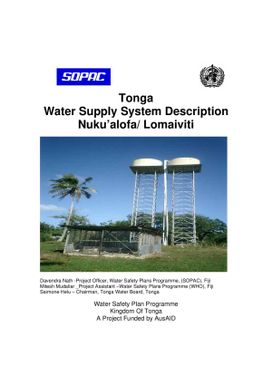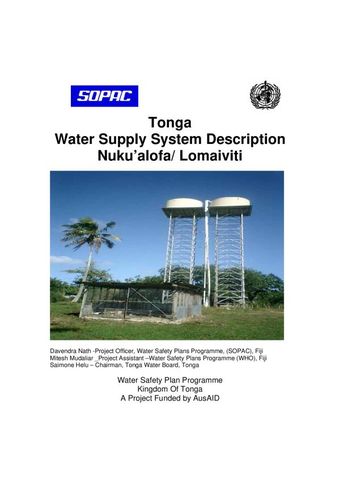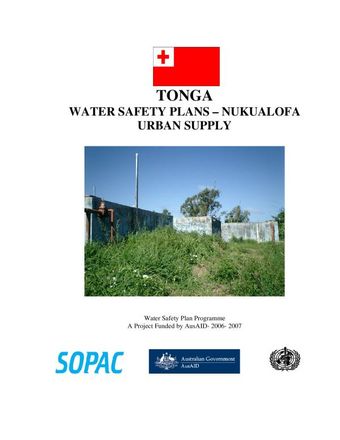Tonga Water Supply System Description Nuku'alofa/Lomaiviti
- Description:
- The importance of safe drinking water for health and development in the Pacific Island Countries (PICs) has been reflected in many regional action plans and policies. Through the Regional Action Plan on Sustainable Water Management (Sigatoka, Fiji, 2002) Pacific Island Countries outlined actions that were needed to achieve sustainable water management through collaborative efforts by water sector authorities and inter-sectoral partners. The WHO workshop on Drinking Water Quality Standards and Monitoring in Pacific Island Countries (Nadi, Fiji, 2005) developed a Framework for Action on Drinking Water Quality and Health in Pacific Island Countries, designed to support the implementation of drinking water quality actions envisioned in the Regional Action Plan. The Pacific Island Countries embraced the Water Safety Plan concept during the workshop and this was reflected in the Regional Framework. It was recommended that PICs should use Water Safety Plans to better manage their water supplies to ensure safe quality drinking water for Pacific communities.
- Collections:
- Secretariat of the Pacific Regional Environment Programme (SPREP)
- Publisher:
- AusAID, Applied Geoscience and Technology Division (SOPAC) of SPC
- Content partner:
- Secretariat of the Pacific Regional Environment Programme (SPREP)
- Availability:
- Not specified
-
Copyright status: All rights reservedFind out more about what you are able to do with this itemThis item is all rights reserved, with means you'll have to get permission from Secretariat of the Pacific Regional Environment Programme (SPREP) before using it. For more information, please see our use and reuse page.What can I do with this item?Non-infringing useNZ copyright law does not prevent every use of a copyright work, and this item may be hosted by an international institute or organisation. You should consider what you can and cannot do with a copyright work.No sharingYou may not copy and/or share this item with others without further permission. This includes posting it on your blog, using it in a presentation, or any other public use.No modifyingYou are not allowed to adapt or remix this item into any other works.No commercial useYou may not use this item commercially.
Related items
Welcome and warm Pasifik greetings
The information on this site has been gathered from our content partners.
The names, terms, and labels that we present on the site may contain images or voices of deceased persons and may also reflect the bias, norms, and perspective of the period of time in which they were created. We accept that these may not be appropriate today.
If you have any concerns or questions about an item, please contact us.


